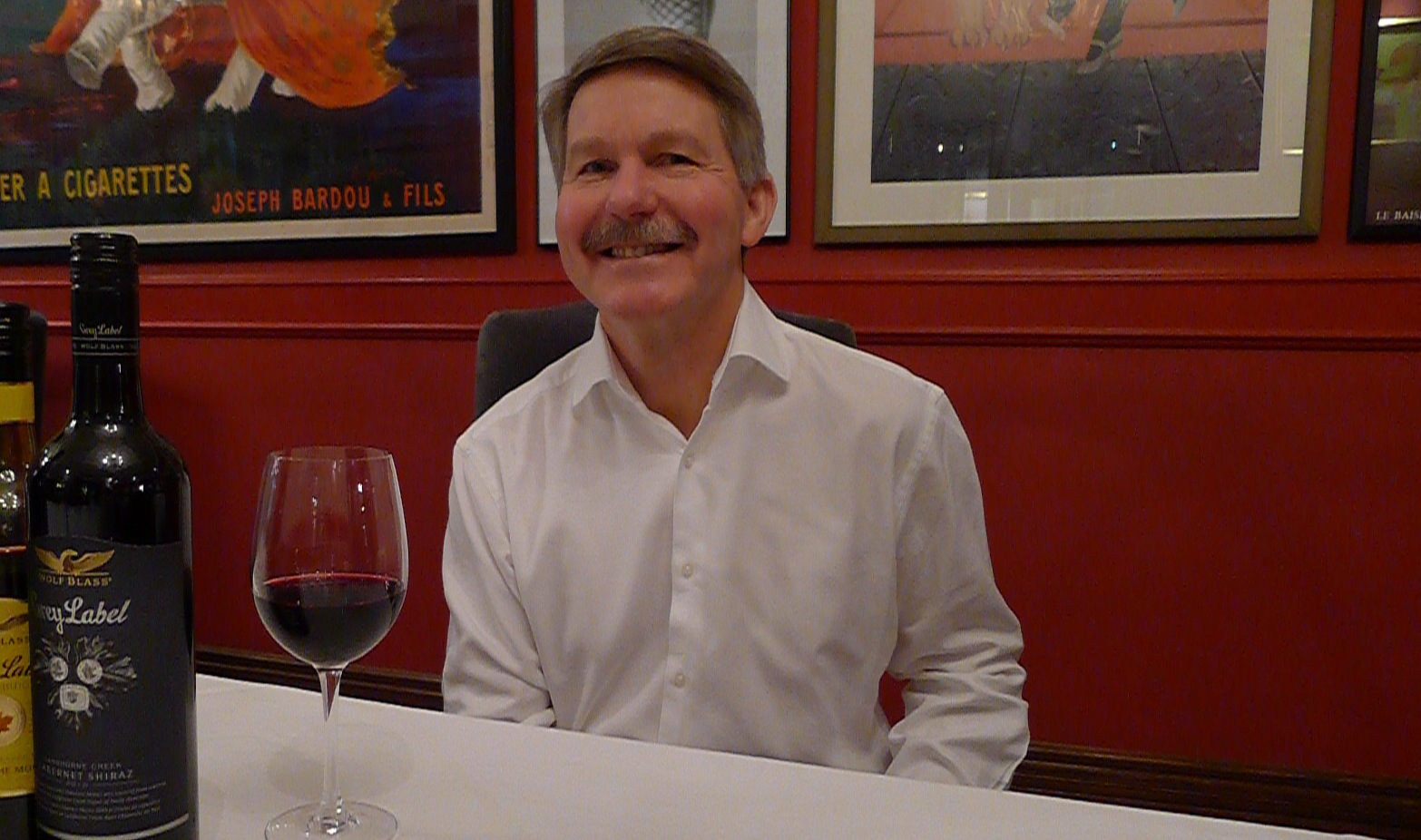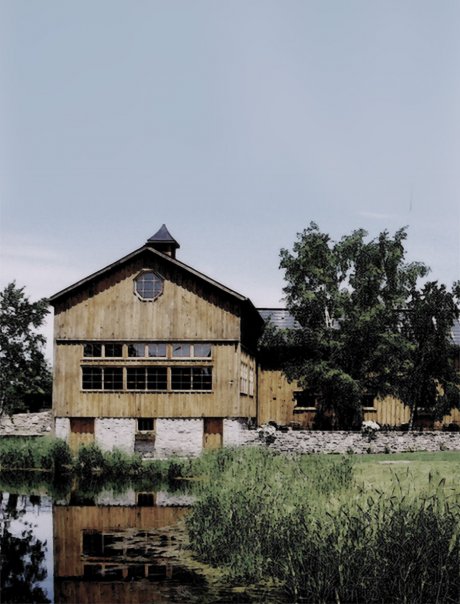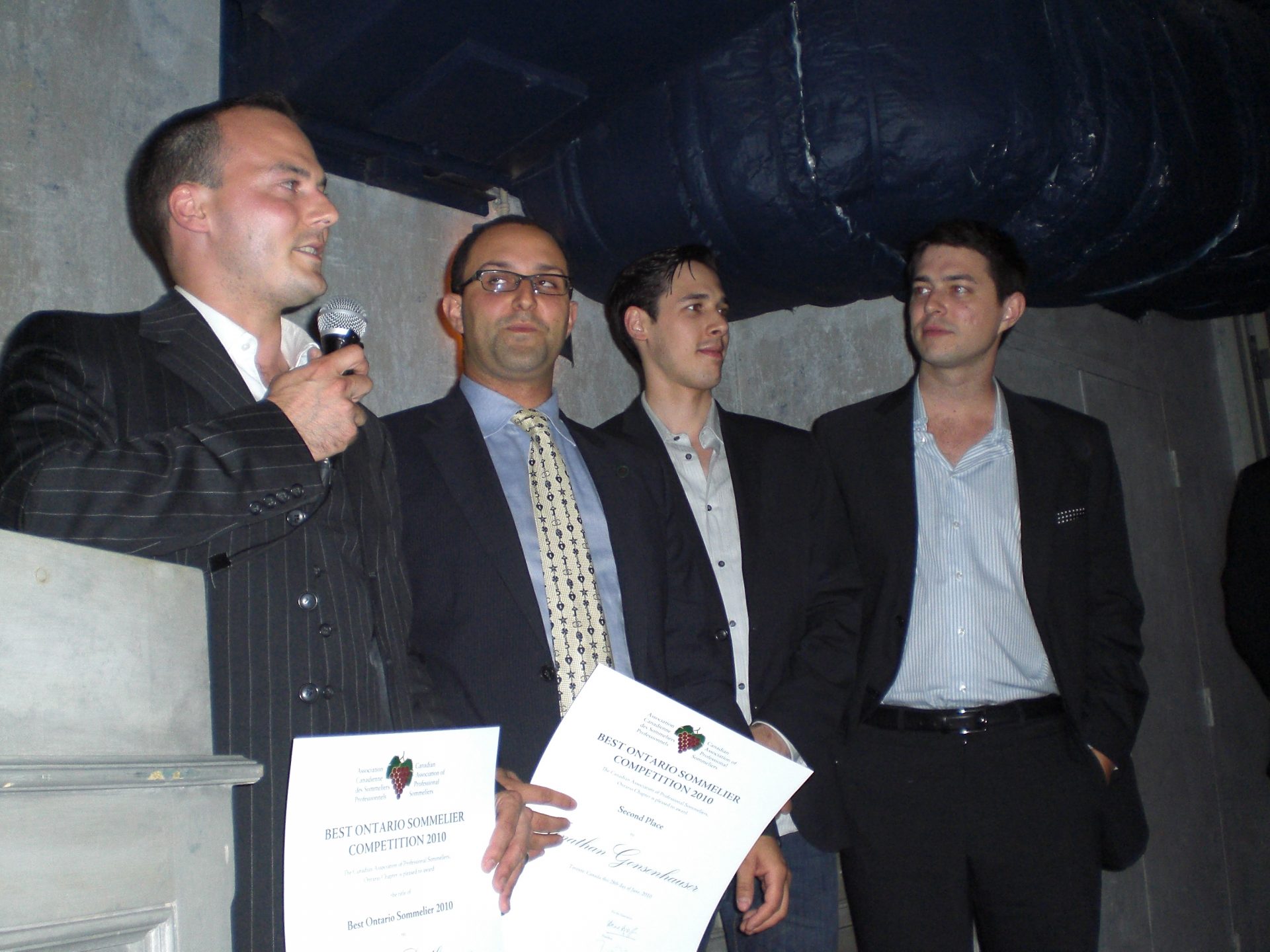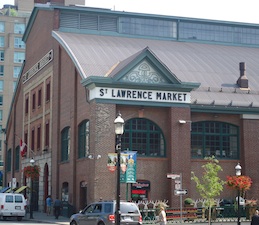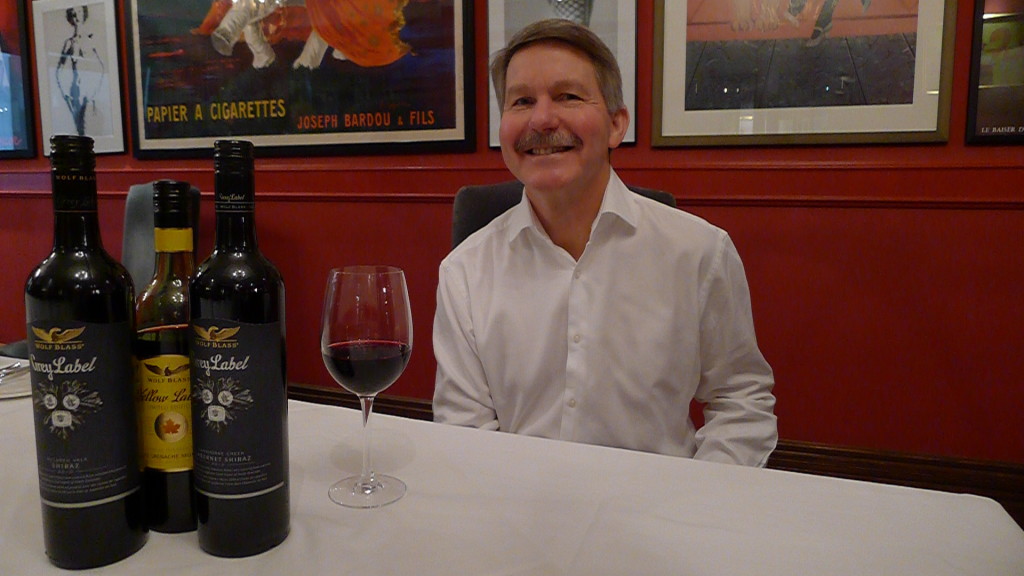
Wolf Blass’ Chief Winemaker, Chris Hatcher at Toronto’s Biff’s Bistro.
When was the last time that you tried one of Wolf Blass’ wines?
I’d highly recommend that you revisit them once again, as over the past five years or so Chief Winemaker Chis Hatcher has revitalised and invigorated a historied brand that dates all the way back to 1966.
In my mind today’s Wolf Blass wines are better than they have ever been, and I’m not the only one who feels that way, with Wolf Blass wines amassing a staggering number of awards and trophies across the globe over the past 12 months. Think of it as a vinous renaissance of sorts.
We caught up with Chris recently to ask him how he feels about all of these accolades, and then we strapped him to the chair and asked him all the difficult questions…
…
If you are having trouble viewing this video please click here.
…
Good Food Revolution: Speaking with you it becomes quickly apparent that wine is in your blood, although I believe that there is quite an interesting story regarding your first introductions to wine?
Chris Hatcher: Most definitely, I was born into a strong Methodist family and there were no alcoholic beverages in our house when I was growing up. Often I was told by my mother how it was the downfall of many good men. As I was somewhat adventurous as a young man I started exploring the things my parents told me were banned and I particularly loved wine.
My main interest at school was Science and in particular biology however I was also very interested in the old world. After completing high school I studied Science at the University of Adelaide and at the end of my first year I took a year off to earn some money. Fortunately I landed a job in the laboratory of the Australian Wine Research Institute and during that time I visited many wineries. I was fascinated by the wine industry as it is a true blend of the old world and Science.
I decided on a career in wine so I returned to University and completed my Degree majoring in Microbiology and Organic Chemistry. My first job was in the Barossa Valley doing research at one of the wineries. I decided winemaking was what I wanted to do so I studied Wine Science at the University of Wagga and moved into a winemaking position after 6 months.
I loved making wine and was very successful at wine competitions from my very first vintage. To my great surprise after making wine for three years my mother informed me that my Great Grandfather Alfred Vesey was actually the first winemaker at Penfolds. He started in the cellar and when Dr Penfolds died back in the late 1800s he became the winemaker. Max Schubert the maker of Grange was one of his trainees.
GFR: And did your parents eventually feel comfortable with you working in the world of wine? How did you convince them that it was a noble profession?
CH: Like most good parents mine only wanted their children to be happy and have a successful life. My mother had a University Degree which was not very common for her generation however my father’s education was limited by the Depression so they work extremely hard to make certain we had the opportunity for a good education. They were very supportive when I decided to go into the wine industry and have been very proud of my achievements. Infact they were happy to have a glass of wine with me when they were older.
GFR: Now, would you mind explaining what your different tiers of wine at Wolf Blass signify?… for those readers who are perhaps a little confused by the different colours of labels.
CH: Back when Wolf Blass started his own winery in the 1960s all of the wines on the shelves in Australia had white labels and no one knew the differences between wineries or varieties. “How was someone meant to remember the wine they liked”? Blass said more than 40 years ago. “There is no point making something if you can’t sell it”.
He wanted people to remember his wines so he used different coloured labels to differentiate them from the other wines on the market. Wine buyers loved the simplicity of the coloured labels and we still use it today as a very easy way for them to differentiate each of the Wolf Blass quality levels and to navigate through each of the price points.
The different labels are:
Red Label wines offer smooth drinking, excellent fruit driven characters and superb value. They are always ready to drink on release.
Yellow Label wines are classical single varietal wines from premium vineyards in South Australia. They are bright, fruit-driven and flavoursome wines with great structure and balance that perfectly compliment food.
Gold Label is a statement of uncompromised quality, elegant wines that showcase both regional and varietal excellence through superb single varietals from South Australia’s best wine regions. Stylistically, they are focused, elegant with great texture and balance. Vibrant fruit aromas and long, supple, perfectly balanced palates are the hallmarks of the Gold Label range.
White Label wines are the best white wines of the vintage, these are outstanding examples of what can be achieved using exceptional quality fruit, passionate winemaking expertise and traditional values.
Grey Label was first wine made by Wolfgang Blass over 40 year ago in 1967. He sourced Cabernet Sauvignon and Shiraz from Langhorne Creek to make a unique Australian wine style, one that offered softness, balance and drinkability, yet with the character to age impeccably. Although the wine style has evolved over the 40 plus years the Grey Label Cabernet Shiraz today still reflects Wolf’s original winemaking philosophy of quality, character and consistency. The Wolf Blass Grey Label Shiraz was first made from the 1975 vintage and is sourced from McLaren Vale. The Grey Label range stands proudly in the Wolf Blass family, enjoying longevity and consistent quality for over four decades.
Black Label is the iconic Wolf Blass red blend. It is a wine with many layers of flavour, intense fruit characters, magnificent structure, a rich lustrous texture, long velvety tannins, carefully integrated oak and a lingering palate. We hand select the best barrels of the year for Black Label and it is predominately a blend of Cabernet Sauvignon and Shiraz. Often it includes a small percentage of Malbec or occasionally Merlot. Regional sourcing may also vary from year to year, although Langhorne Creek, the Barossa Valley and McLaren Vale tend to dominate most years. It’s not about individual regions, vineyards or varieties, but rather the crafting of them together to create a wine far greater than the sum of its parts.
Platinum Label is the ultimate contemporary Australian Shiraz. It is from the Medlands Vineyard, a single vineyard in the sub-region of Dorrien in the Barossa Valley. It expresses the unique terroir and very essence of Barossa Shiraz, enhanced by our winemaking experience and skill. The unique Medlands Vineyard sits on the banks of the North Para river and produces fruit of the intensity, finesse and structure that a wine of Platinum Label’s calibre demands.
GFR: How does Wolf Blass being part of an international corporation affect the decisions that you make from day to day in the vineyards and at the winery?
CH: Being part of an international company has given us access to capital to invest in our winery, vineyards and experimentation. We are no longer forced to compromise on quality as we have better resources and equipment to achieve our objectives. Our winemaking team have a very good track record with respect to understanding the styles and quality required so the company has never dictated how we should make our wines, that is left to the winemakers. Our day to day decisions are all made to achieve the highest quality we can for every wine we make.
GFR: I say winery singular, but I’m guessing that perhaps you have more than one winery?
CH: No we only have one Wolf Blass winery. Controlling multiple wineries adds complexity and so the potential for oversight. I strongly believe winemakers make the best wines by working closely with the vineyard teams throughout the growing season and then controlling fruit harvesting followed by fermentation, maturation and bottling of their wines in their winery.
Excellence in winemaking is achieved by making good decisions at every critical step in the winemaking process. Attention to detail is fundamental to success and it is definitely very “hands-on”. Great wines cannot be made sitting in an office.
GFR: Just to put things into perspective for our readers, what is Wolf Blass’ annual production in bottles?
CH: We do not discuss our make volumes however I can tell you that we make very small volume single vineyard wines like our Medlands Vineyard Platinum Label (500 and 1,000 cases) through small volume wines like Black Label (1,000- 2,500 cases) and Grey Labels to our larger volume affordable wines like Yellow Label. To put that into context the First Growth Bordeaux volumes range from 15-20,000 cases and Dom Perignon 300-350,000 cases.
GFR: It must be a great responsibility on your shoulders having to maintain quality for all of those bottles across all of your bottlings? How the hell do you maintain consistency with that kind of volume?
CH: The key to maintaining consistency is to have a passionate, dedicated team of winemakers that understand the quality and style required for each wine we make and the dedication and attention to detail to ensure that every step in the winemaking process is meticulously completed. We have an excellent blend of experience and youth in our team of winemakers at Wolf Blass.
GFR: I know that you are usually asked which is your most favoured of wines… but I’m not going to let you get off that easily… which of your wines has proven itself to be the most difficult and challenging wine for you to make? Both from the past and from your current lineup? Which ones were the absolute buggers to get to the point where you were happy having your name on the bottle?
CH: Without doubt making world class Chardonnay has been the biggest challenge for Australian winemakers. At Wolf Blass it has taken us over 20 years to change our style from a heavily oaked, big broad style to and elegant, cool climate well balanced wine that continually surprises wine experts around the world. I am particularly proud of our 2012 White Label Piccadilly Chardonnay and Gold Label and Yellow Label Chardonnays from 2013.
GFR: Since you came on board as Chief Winemaker (1996?) would it be fair to say that you brought the wines of Wolf Blass into the modern age after a couple of decades of stagnation in the 70’s and 80’s? I’m not saying that those were bad wines by any means Chris, but they are a long way removed from the Wolf Blass wines of today. What exactly was it that you did to achieve this?… and you can be as technical as you wish!
CH: Great success often leads to a conservative approach and maintaining the things that furnished the success. The unprecedented achievements of Wolf Blass in the 1970s and 1980s lead to a stagnation in the winery and a reluctance to continually evolve. In the 1990s the wines were still very good but had become a little old fashioned. When I became the Chief Winemaker in 1996 I was determined to bring Wolf Blass into the modern era whilst maintaining the elements that wine buyers loved about the wines from Wolf Blass.
I was looking to make wines with bright fruit characters that reflected our regions, wines with great clarity and intensity without over extraction. We change our fruit sourcing with more focus on the Barossa, McLaren Vale, Langhorne Creek, Adelaide Hills and Coonawarra, reduced the amount and quality of American oak and used more French oak and went back to the fundamentals of fermentation and maturation in the winery. Today other than our iconic Black Label all of the wines above Yellow Label are regional and are matured in exclusively or a high percentage of French oak.
Our red fermentation management is heavily focussed on soft extraction to give great depth of fruit flavour without heavy tannin extraction. We have reduced the maturation time in oak and increased the time in bottle before release to maintain freshness and brightness of fruit. The introduction of screwcap in 2001 also helped maintain freshness in our wines as they age.
GFR: Along with Yellow Tail, I feel that Wolf Blass’ Yellow Label came in for a lot of criticism over the past decade, from both professional wine critics and the general public. What are your thoughts on the way that less expensive Australian Shiraz rose to prominence, dominated the markets, and then rather disastrously fell from grace? And how did this affect both your sales/export numbers?
CH: I cannot speak for Yellowtail or other Australian producers on this subject as I don’t have an intimate knowledge of their winemaking or sales performance. Wolf Blass has not ridden on the rise and dominance of less expensive Shiraz, infact our most successful wines globally are Cabernet based wines and our biggest selling wine is Yellow Label Cabernet not Shiraz. Overall in our domestic and international markets we are in growth and have not suffered a fall from grace. I believe our continued success is because we make wines that people enjoy drinking and are true to our mantra Quality, Character and Consistency. We do not chase fads but instead continually evolving and tweak our wines so they remain relevant.
GFR: And so was the “formula” changed to combat this? I notice that today’s Yellow Label wines taste nothing like those of ten, maybe even five years ago? And for the record they are MUCH better!
CH: There is no question Yellow Label and our other wines are much better today than they have ever been. In 2001 we built a new winery that incorporated old world winemaking techniques like small batch open top fermenters for soft extraction and gravity feeding of red presses to avoid bitter extraction. The “small batch” philosophy and techniques of winemaking used on our luxury wines are also used on our more affordable wines like Yellow Label.
The other factor that has dramatically improved in the last decade is our fruit quality. As our global markets rapidly expanded in the late 1980s through the 1990s there was a huge planting program in Australia and so until recently a large percentage of our medium priced wines were made from fruit harvested from young vines. Today all of our vines are mature giving us wines with increase depth of fruit, intensity and balance.
GFR: So looking at Australian wines as a whole, do you see a sea change in wine styles, and how has this been received in your various markets?
CH: The biggest improvement I have experienced in almost 40 years in the industry is the improvements in our vineyards. When I started most of the vineyards were in the warmer regions and grape growers were generally mixed farmers and grapes were almost a sideline. Varieties and clones were limited and most were grown in every region with no specialisation.
Today growers are very professional, well-educated and we have planted in many new cool climate regions across Australia. Growers are planting specific varieties that produce the best quality wines for their region so today there is a great diversity of varieties and styles. We no longer require heavy oak maturation to build flavour as our vineyards are delivering the flavour, quality and style we are looking for and our wines are now world class.
The change has been a maturing of our industry and a realisation that our regions and climatic differences define our quality and not just the winemaker. It has definitely been an evolution not a sea change and so the change has been gradual and our consumers have come along the journey with us.
GFR: Although Wolf Blass has undoubtedly proven that it can change with the times, what parts of the Wolf Blass traditions do you feel that it is important to preserve?
CH: Our mantra has always been Quality, Character and Consistency and that will never change. Wolf Blass developed a new innovative style of red wine for Australia in the early 1970 with wines that had round plush middle palates with soft balanced tannins. Wines that were very drinkable when released to the market but had the ability to age very well.
The palate structure defines the Wolf Blass style and over extraction has never part of it. Today we have access to fruit that has excellent regional and varietal flavours with great depth and intensity so the modern wines from Wolf Blass have bright fruit characters, excellent clarity and do not rely on oak for character. Although we are continually evolving our wines we have and always will preserved the palate structure of the original Wolf Blass wines so they are true to the style.
GFR: Chris, it has been a pleasure speaking with you. Thank you very much for your time and indepth answers! Now let’s undo those straps…
…
 Edinburgh-born/Toronto-based Sommelier, consultant, writer, judge, and educator Jamie Drummond is the Director of Programs/Editor of Good Food Revolution… And he’s deadly serious, you have to revisit these wines!
Edinburgh-born/Toronto-based Sommelier, consultant, writer, judge, and educator Jamie Drummond is the Director of Programs/Editor of Good Food Revolution… And he’s deadly serious, you have to revisit these wines!

